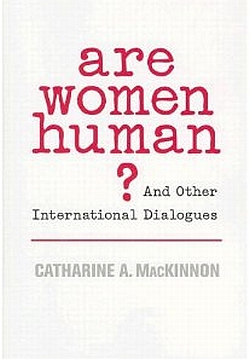 On this September 11th memorial let’s consider Catharine MacKinnon’s book Are Women Human? And Other International Dialogues. Catharine MacKinnon, a Minnesotan, is an international lawyer at The Hague. Her background is impressive enough. However, last fall I heard her speak at the University of Chicago and I can attest that she is even more impressive in person.
On this September 11th memorial let’s consider Catharine MacKinnon’s book Are Women Human? And Other International Dialogues. Catharine MacKinnon, a Minnesotan, is an international lawyer at The Hague. Her background is impressive enough. However, last fall I heard her speak at the University of Chicago and I can attest that she is even more impressive in person.
“MacKinnon is the Elizabeth A. Long Professor of Law at the University of Michigan Law School.[3] In 2007, she served as the Roscoe Pound Visiting Professor of Law at Harvard Law School.[4]MacKinnon is a highly cited legal scholar.[5][6] She has frequently been a visiting professor at other universities and regularly appears in public speaking events” (Wikipedia).
In Part Four of her book,, entitled “On the Cutting Edge,” she unmasks the narrative of the lie of September 11, 2001.
“Every other day, as well as this one, men as well as women are victimized by men’s violence. But it is striking that the number of people who died at these men’s hands on September 11th, from 2800 to 3000, is almost identical to the number of women who die at the hands of men every year in just one country, the same one in which September 11th happened. Women murdered by male intimates alone could have filled one whole World Trade Tower of September 11’s dead. This part of a war on women in only one country, variously waged in all countries, is far from sex-equal on either side” (italics author’s, 261).
“Compare the response to September 11th with excuses for doing nothing about violence against women. . . Will it be said that some individuals are just violent, so nothing can be done/ Will terrorism be seen as cultural, hence protected? Will the United States throw up its hands when it learns that Al Qaeda, like some pornographers and other sex-traffickers (sex their religious as well as their business) is organized in (what for men are) unconventional ways? Violence against women is imagined to be nonstate, culturally specific, expressive acts of bad apple individuals all over the world that is so hard to stop. Terrorism, which is all of these, is said to be so serious that there is not choice but to stop it, while seriously addressing threats to women’s security is apparently nothing but a choice, since it has barely begun” (269).
Here’s the bottom line. She notes that the attack on September 11th wasn’t considered serious and tragic because people were killed. “Women are killed every day and there is not a similar outcry or mobilization of resources. It was considered serious and tragic because powerful, white males were killed. Powerful white males became fearful for their own safety” (italics author’s, 275).
“ The fact that Al Qaeda is not organized into a nation with armies and territory did not stop this international response before it started. No one argued that the bigger Al Qaeda is, the less can be done about it. Yet the fact that male dominance is not organized as a state, but like Al Qaeda is literally transnational and pervades the world, is used to keep male violence against women largely unopposed in the international system” (268).
“ . . . international law still fails to grasp the reality that members of one half of society are dominating members of the other half in often violent ways all of the time, in a constant civil war within each civil society on a global scale – a real world war going on for millennia” (266).
“When the photographs of American soldiers sexually humiliating Iraqi detainees at Abu Ghraib prison surfaced, the fact that identical acts are routinely committed against women (and some men) in pornography was typically mentioned, if at all, to excuse the crimes, not to indict the pornography. The connection was not lost on one Iraqi man who was abused by Americans in prison. ‘They wanted us to feel as though we were women,’ he said, ‘the way women feel, and this is the worst insult, to feel like a women’” (273).
“The photos, mild by pornography’s standards, were routinely referred to as pictures of torture, yet calling pornography pictures of torture is usually derided as an extremism comparable to calling violence against women a war” (273).
“ It is hard to avoid the impression that what is called war is what men make against each other, and what they do to women is called everyday life” (274).
Her words should shock us into reflection and out of our romantic notions of patriotism and patriarchy. Let’s remember the victims of 9-11, but let’s not forget thousands of women who die every year in this country and even more around the globe – at the hands of men – husbands, fathers, uncles, brothers, cousins and grandfathers.
You may also like Patriarchy: Abusive by Design and Resisting Patriarchy.